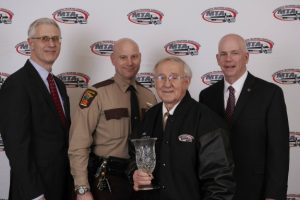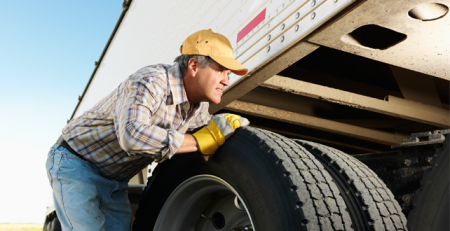It’s Not A Revolution. The Autonomous Truck Has Been Developing For More Than Two Decades.
 This year, Freightliner and Peterbilt demonstrated their autonomous trucks to an eager trucking industry press corps, and Google showed its self-driving, computer-connected passenger car. All got a lot of press and sparked a good deal of discussion about the future of transportation.
This year, Freightliner and Peterbilt demonstrated their autonomous trucks to an eager trucking industry press corps, and Google showed its self-driving, computer-connected passenger car. All got a lot of press and sparked a good deal of discussion about the future of transportation.
These self-driving vehicles are the result of a long line of developments in computerization. Back in 1975, Gordon Moore, the founder of Intel, predicted that computer chips would double their capability every two years or so. He was right and we now accept his vision as Moore’s Law. Not only has processing speed progressed accordingly, so has memory size and computer abilities to address and process all the additional data. Trucking reaped many benefits as a result, starting with electronic fuel injection and automated manual transmissions.
Less effort required
Eaton’s Top 2 transmission took the first steps to automation in an effort to reduce driver fatigue, using vehicle and engine speed data to determine when to shift from 9th to 10th and back, since that accounted for more than 90 percent of a driver’s shifting. As computer capacity grew, the concept was expanded to include all gears. Just as an experienced driver would, computers “floated the gears,” matching engine and transmission rpm without using the clutch. Driver fatigue was greatly reduced, and even seasoned veterans appreciated the reduced effort.

Soon, the clutch pedal, used only to engage and disconnect the transmission for stops, was eliminated. Clutches were computer-actuated. The best drivers were accurate more than 95 percent of the time, but computers were 100 percent accurate and wouldn’t leave drivers hung out in neutral on a hill. The latest advances in computer capacity allow the newest transmissions to tailor shift timing to various vocational demands and to add safety features like creep control and hill holding.
Operating within lanes and around obstacles
Image recognition software allows computers to determine the boundaries of driving lanes and to alert drivers when they drift too close to the edges. When first tested, suppliers feared that drivers would report such devices as being too much like “Big Brother,” constantly spying for the company. Quite the opposite took place. Drivers appreciated the safety and security these lane departure warning (LDW) devices offered, and in several test fleets, a significant number requested LDW on their trucks. Several component suppliers today are developing LDW systems tied to power steering to actually prevent lane departures. Turning on a directional signal silences any warnings and overrides the computer controlling steering.
VORAD, or Vehicle On-board Radar, started as a warning system for trucks following too closely to vehicles in front of them. Drivers received audible and visual warnings as following distance decreased. Computer capability improved, and VORAD evolved into adaptive cruise control. If traffic ahead slowed, your vehicle would also slow to maintain a pre-set following interval. It was accomplished by de-fueling the engine. The cruise control computer communicated with the engine-management computer to slow the truck or accelerate it back to its pre-set speed. If traffic slowed too rapidly or if a solid object fell in your path, audio and visual alerts would sound. Today, there are versions of adaptive cruise control that will apply the service brakes and bring the vehicle — car or truck — to a complete stop.
Can you see the pattern developing? Not only did computer chips become capable of processing more data more quickly, they gained the ability to communicate with each other.
Putting on the brakes
 Anti-lock braking systems (ABS), initially mandated in the mid-1970s, were more dangerous than effective at that time, proving that government cannot legislate technology, only encourage it to evolve. After the federal courts blocked the requirement, ABS evolved under private industry to become a proven, trusted technology. It was mandated a second time, with no problems in implementation.
Anti-lock braking systems (ABS), initially mandated in the mid-1970s, were more dangerous than effective at that time, proving that government cannot legislate technology, only encourage it to evolve. After the federal courts blocked the requirement, ABS evolved under private industry to become a proven, trusted technology. It was mandated a second time, with no problems in implementation.
Some might argue that EPA regulations brought about the development of electronic engines to meet emissions standards, but others believe that the EPA encouraged and focused the application of technologies that were already developing.
Electronic stability control (ESC) and rollover stability control (RSC) use multiple computers to maintain balance in a vehicle. When sensors detect skids or excessive roll in tractors or trailers, they communicate to modules that process the information in milliseconds, far faster than the fractions of a second it takes the human mind to identify and process the sensations, let alone act on them. It can save 50 feet or more reaction distance. Before humans can react, vehicle computers can reduce flow through the fuel injectors and selectively apply the exact amount of pressure to brakes individually or in groups in order to mitigate or, more likely, prevent a stability incident. The situation will usually be controlled and ended before a human can sense an incident is — or has been — happening.
A better view
Vision is the primary sense drivers use to operate their vehicles, yet it was the one least affected by computerization — until now. Peterbilt has incorporated television and infrared technologies in its Safety Technology Truck. The National Highway Transportation Safety Administration’s Federal Motor Vehicle Safety Standards for manufacturers still require flat glass mirrors on both sides of all trucks, but miniaturized television cameras can provide more effective and more versatile all-around vision while allowing builders to improve aerodynamics dramatically.
By replacing outside glass with cameras, fuel economy can be improved by as much as five percent.
The Peterbilt project is still under development, but currently has four TV modes: split screen, side-by-side images of the outside mirrors; an infrared option for enhanced night vision, a 360 degree “view from the top” all around image and a rear view camera for backing or hooking up trailers. Peterbilt is still working out locations for monitors.
A major piece of the puzzle needed to complete the autonomous truck is GPS. Early global positioning systems were developed for military targeting and navigation purposes, but since their declassification and release of technology for general use, GPS has spawned an entire industry. Receivers calculate position anywhere on earth by triangulating from up to eight satellites located in fixed orbits. Commercial GPS devices then compare that location to locations stored in computer memory and plot routes to destinations according to your parameters: fastest or shortest route or routes; avoiding tolls, ferries or highways — just to name a few.
Everything is connected
As computers’ capacities to absorb and process data increases, we can increase the volume of information in the database. We already include speed limits in today’s GPS units that can measure speed and issue warnings when limits are exceeded. Such fixed data can also include information about hills and other highway conditions.
Tying in with extended data sources will make autonomous trucks and cars eventually feasible. The technologies are broadly referred to as vehicle-to-vehicle (V2V) and vehicle-to-infrastructure (V2I). V2I is already in use with alerts about traffic, construction and weather.
The next stage would be to have vehicles communicate back to the infrastructure their whereabouts and planned routes. Massive computers might then process this data to more efficiently adjust traffic lights, for example, to optimize traffic flow.
V2V will allow cars and trucks to communicate with each other, then to let each other know not only where they are, but where they’re going. It will help prevent two vehicles from occupying the same space at the same time. All it may take is for one vehicle to increase speed one-half mile an hour while the other decreases speed. Imagine knowing where every vehicle within a quarter-mile is and what they’re doing. Moore’s Law can help that happen.
Source: http://roadking.com/trucks/
Visit us:
301 W Gerri LnAddison, IL 60101
Contact us:
Phone: +1 224 422 2829
Mail: info@tire-max.com










